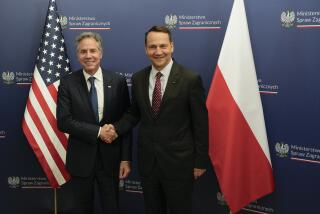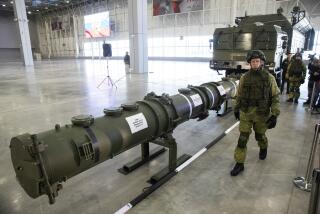Reagan Hails ‘Breakthrough’ on Euromissiles
WASHINGTON — President Reagan on Thursday hailed the progress in the intermediate-range arms talks with the Soviet Union as a “great breakthrough” toward an agreement to eliminate these missiles from Europe and to limit each side to 100 warheads elsewhere.
Although verification still looms as the major obstacle to success, Reagan said that the Administration’s policies of “preparedness, patience and firmness” had produced the change in the Soviet position last weekend that puts an agreement within reach.
“I’ve never felt more optimistic about the prospects for success in this area than I do today,” he told a meeting of the National Newspaper Assn. here. However, he singled out shorter-range missiles and verification as key remaining difficulties.
A”We need to agree on equitable constraints on shorter-range INF (intermediate nuclear force) missiles because the Soviets must not be able to circumvent an agreement on the longer-range missiles through a buildup on the short-range ones,” he said. “And, to be sure that the Soviets keep their word, we must continue to insist that all agreements will be effectively verifiable.”
‘Cradle to Grave’
Verification measures designed to police the agreement promise to be the biggest problem by far, senior officials and non-government experts say, as the United States seeks what some specialists have ironically labeled “socialist verification”--meaning “cradle to grave” monitoring of missiles from their production through deployment and eventual dismantling and destruction.
Such demanding requirements in the proposed U.S. treaty have drawn objections from West Germany and Britain. “The Soviets, under the wording of the draft, could even go into Langley searching for missiles,” one U.S. official said. Langley, Va., is the headquarters of the CIA.
The U.S. verification provision would give Soviet officers inspection rights on U.S. territory and within the borders of Britain, West Germany, Italy and Belgium, where U.S. intermediate-range Pershing 2 and cruise missiles have been deployed.
Willing to Compromise
As a result of allies’ complaints, the Administration is willing to ease some of the stricter conditions in the package of verification measures before it is formally transmitted to the Soviets as an annex to the draft treaty that was presented to them this week, a senior official said.
For example, the draft sent to the allies proposed that the Soviet Union and the United States would allow on-site inspection at any facility suspected of producing, storing and/or assembling the weapons. Now, however, the wording may be revised to require that the suspect facility be shown to be related to intermediate-range missile production or storage.
Jack Mendelsohn, deputy director of the private Arms Control Assn., said earlier this week that the Administration’s verification package is “an enormously complex panoply of measures” from production through destruction of missiles.
3 Elements Cited
A senior U.S. official rejected that description but acknowledged that even the White House had balked at some of the verification measures initially requested by the Pentagon. He said the U.S. package consists of three elements:
--An “initial base-line count,” or inventory, of the existing missiles on both sides and a continuous exchange of data as the count changes with the dismantling of weapons. Each side can inspect the other’s facilities to ensure that the count is correct.
--”Perimeter and portal monitoring” of production, storage and final assembly facilities. Each side could station men and equipment around these facilities and inspect crates above a certain size and weight that emerge from their “portals.” The official said that the Soviets have between six and eight facilities whose perimeters and portals would be monitored by about 200 Americans.
--”Designated deployment areas” for the 100 warheads each side could retain. Missiles would be permitted only in those areas, but those within the designated areas would not be officially counted or inspected, though spy satellites might be able to accomplish that task. Any missiles found outside the areas would be considered violations.
“Covert production” of the missiles at facilities not identified poses the most difficult problem. Production from secret plants would be considered violations if detected outside the deployment areas.
Siberian Region
The United States wants all the Soviet missiles confined to a Siberian region near Novosibirsk, about equally distant from Western Europe and the United States. The Soviets want the U.S. weapons within the 48 contiguous states, not in Alaska, where they would be within striking distance of Soviet targets.
In addition, Mendelsohn said, the United States will call for on-site observation of the dismantling and destruction of those weapons above the permitted number. The Soviet Union would have to destroy about 410 SS-20 missiles, each of which now carries three warheads, leaving it with 33 such weapons carrying 99 warheads. The United States would destroy 108 of the 208 currently deployed missiles, each of which has a single warhead.
The Soviets, historically paranoid about foreigners on their territory, opposed the very principle of on-site inspection until last year. Although they now embrace it, they have yet to spell out what are acceptable and unacceptable degrees of intrusiveness.
More to Read
Sign up for Essential California
The most important California stories and recommendations in your inbox every morning.
You may occasionally receive promotional content from the Los Angeles Times.










